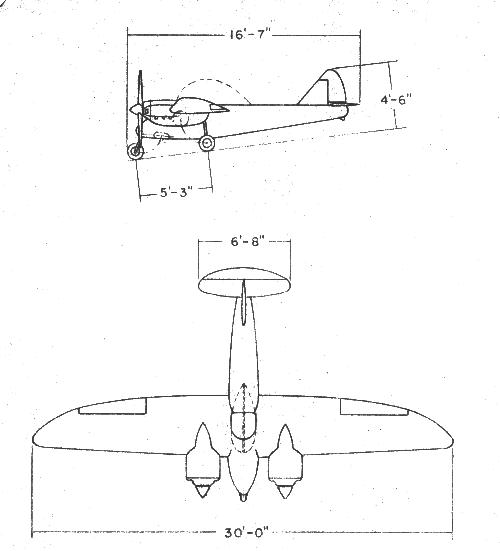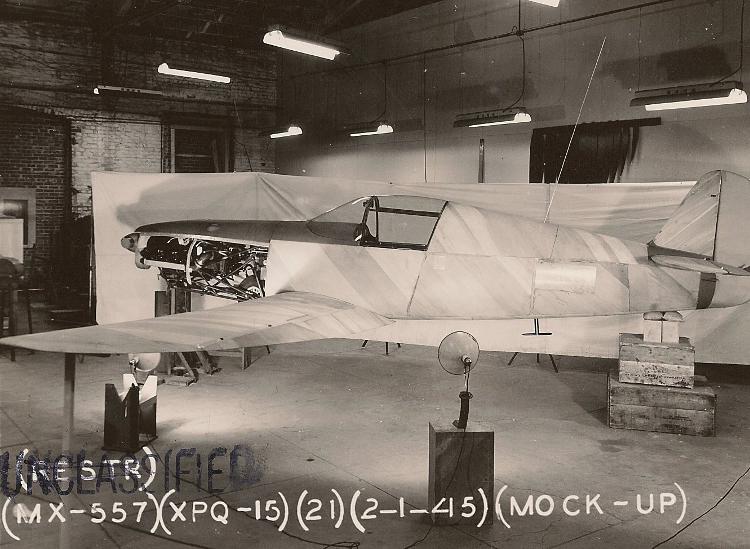PQ Series
(PQ-8 through PQ-15)
Between 1940 and June 1941, the USAAC used an A-for-Aerial Target designation category for radio-controlled aircraft used as gunnery targets. However, these designations could be easily confused with the A-for-Attack series, and therefore two new categories were introduced: OQ for subscale target drones, and PQ for full-scale aircraft with provision for an on-board pilot. Existing A-series models were redesignated in the appropriate new series, but the model numbers were left unchanged. Because only the last A-series drone, the Culver A-8, was thus redesignated as PQ-8, the PQ-series was effectively a continuation of the A-series. Therefore numbers PQ-1 through -7 remained unused.
Culver PQ-8 Cadet
The PQ-8 is dicussed on a separate page, see PQ-8/TDC Cadet.
Culver PQ-9
In 1941, Culver designed the model NR-B as an improved PQ-8 Cadet with a more powerful Franklin O-300-3 engine, and the USAAF planned to evaluate the NR-B target drone as the PQ-9. However, the XPQ-9 prototype and the PQ-9 production version were cancelled, presumably because the PQ-14 (Culver model NR-D) was more promising.
 |
| Photo: Flying Magazine |
| XPQ-9 |
Official USAAF sources say that no XPQ-9 or PQ-9 aircraft were completed. However, the airframe in the heavily retouched photo above has been reliably identified as an XPQ-9. The most likely explanation seems to be that the USAAF never officially accepted the aircraft, which therefore doesn't appear in any tabulations of acquired airframes.
Culver PQ-10
In 1941 the USAAF ordered a single XPQ-10 radio-controlled target from Culver. The XPQ-10 was based on Culver's model MR design, a two-seat twin-engined aircraft with a wingspan of 6.4 m (21 ft) and a tricycle landing gear. The engines were to be two Franklin O-300. However, the XPQ-10 was cancelled before completion, and plans to acquire a batch of PQ-10 production drones were also dropped.
 |
| Image: Fagan Collection, via George Cully |
| XPQ-10 |
Fletcher PQ-11
The PQ-11 design was based on the Fletcher FBT-2, which was offered unsuccessfully as a military trainer. In late 1941, the U.S. Army Air Force ordered one XPQ-11 radio-controlled target drone, powered by a Pratt & Whitney R-985 engine, but the order was cancelled before completion of the aircraft. The USAAF instead chose to procure the Culver PQ-8 Cadet and PQ-14 drones. Ten PQ-11A production models had also been ordered, but were completed as XBG-1 bomb gliders.
 |
| Photo: Fagan Collection, via George Cully |
| XPQ-11 |
Fleetwings PQ-12
The PQ-12 design was a radio-controlled target drone with a fixed tricycle landing gear and an open cockpit for an optional on-board pilot. It was powered by a single Lycoming O-435-5 piston engine of 167 kW (225 hp). A single XPQ-12 ordered in 1941 was cancelled, but one XPQ-12A and eight YPQ-12A aircraft were delivered to the USAAF. A production batch of 40 PQ-12A drones was also cancelled.
 |
| Photo: ATSC |
| XPQ-12A |
The YPQ-12A had provision to carry a 225 kg (500 lb) bomb as a payload in place of the pilot. In October 1943, two YPQ-12As were fitted with a TV camera and a bomb, and were guided by an airborne operator to impact into a test target. The test was moderately successful, and was part of the development effort for the Fleetwings BQ-1/BQ-2 radio-controlled assault drones.
Erco PQ-13
In 1941, the U.S. Army Air Force purchased two examples of the Erco Ercoupe 415-C and converted them to radio-controlled drones with the designation XPQ-13. The PQ-13 was not produced in quantity, because the Culver PQ-14 was the superior design for that purpose. However, one XPQ-13 was used for the USAAF's first tests of JATO (Jet-Assisted Take-Off) rockets to significantly improve an aircraft's take-off performance. These tests were very successful and led the way for standard application of JATO on many operational aircraft.
 |
| Photo: Harry L. Francis |
| XPQ-13 |
Culver PQ-14
The PQ-14 is dicussed on a separate page, see PQ-14/Q-14/TD2C.
Culver PQ-15/TD3C
In 1945 the USAAF purchased four XPQ-15 target drones, and the U.S. Navy evaluated two examples under the designation XTD3C-1. Source [1] states that the XPQ-15 was a drone version of the Culver V light aircraft, powered by a Franklin O-405 engine, but this is an error because the XPQ-15 was a completely different design.
 |
| Photo: via George Cully |
| XPQ-15 (mockup) |
Specifications
Note: Data given by several sources show slight variations. Figures given below may therefore be inaccurate!
Data for XPQ-11, XPQ-13, XPQ-15/XTD3C-1:
| XPQ-11 | XPQ-13 | XPQ-15 / XTD3C-1 | |
|---|---|---|---|
| Length | 7.07 m (23 ft 3 in) | 6.32 m (20 ft 9 in) | ? |
| Wingspan | 9.14 m (30 ft) | 9.14 m (30 ft) | ? |
| Weight | ? | ||
| Speed | > 320 km/h (200 mph) | 188 km/h (117 mph) | 354 km/h (220 mph) |
| Ceiling | 5800 m (19000 ft) | ? | |
| Range | 870 km (540 miles) | 560 km (350 miles) | ? |
| Propulsion | P&W R-985 piston engine; 330 kW (450 hp) | Franklin O-300 piston engine | Franklin O-405 piston engine; 150 kW (200 hp) |
Main Sources
[1] John M. Andrade: "U.S. Military Aircraft Designations and Serials, 1909 to 1979", Midland Counties, 1979
[2] James C. Fahey: "U.S. Army Aircraft 1908-1946", Ships and Aircraft, 1946
[3] US Army Air Forces: "Army Aircraft Model Designations", 1946
[4] Aerofiles Website
[5] "Flying Magazine", April 1946 and October 1946 issues
Back to Directory of U.S. Military Rockets and Missiles, Appendix 1
Last Updated: 7 February 2012